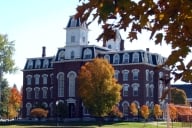You have /5 articles left.
Sign up for a free account or log in.
Over the latter quarter of the 20th century, the medical establishment generally took the view that the United States was on track to have a glut of doctors, and medical schools largely responded throughout the 1980s and 1990s with flat enrollments. In the last few years, however, some researchers and public policy makers have argued that the strategy may have worked a little too well, and that because some of the expected changes in American medicine haven't unfolded in the predicted ways, the country now actually faces a physician shortfall over the next decade.
Citing those reports, the Association of American Medical Colleges on Monday called for a 30 percent increase in the enrollments of medical schools in the United States, both through expanding the size of existing schools and creating new ones. Just last year, the medical college group urged a 15 percent increase in enrollments, but its officials said that mounting new evidence assembled by its Center for Workforce Studies had persuaded officials that a larger rise was needed.
"Given the extensive time it takes to educate and train tomorrow's doctors, efforts to increase enrollment must get underway as soon as possible to ensure that the health care needs of the nation in 2015 and beyond are met," said Jordan J. Cohen, president of the AAMC. The group's proposal would result in 5,000 new M.D. students annually.
Health care researchers like David C. Goodman, a professor of pediatrics at Dartmouth Medical College, challenge the notion that the country faces an undersupply of doctors, and argue instead that a redistribution of where the doctors are and what they do could not only meet Americans' medical needs but improve the quality of their care. "A proposal like this would add costs to the system without evidence that this is going to help patients," says Goodman, who compares the proposed enrollment increase unfavorably to other spending, such as greater health insurance or investing in quality initiatives, that directly improves care.
Ed Salsberg, the AAMC assistant vice president who directs its workforce studies center, acknowledges that skeptics may ask health care planners like him, "You were wrong before, why should we believe you now?" But he says several demographic and other factors contributed to the association's decision to recommend bigger enrollment increases .
First, the assumption that changes in managed health care would greatly diminish demand from patients -- an assumption that underscored the projections of the physician oversupply in the 1980s and 1990s -- has largely failed to materialize. Second, the American population continues to increase and age, such that "by the time these doctors will be out in field, the baby boomers will be 70." Third, about 250,000 of the nation's 750,000 or so doctors are age 55 or older, expected to retire by 2020.
Underlying the medical college association's statement is the assumption that while doctors educated at "osteopathic schools and schools outside the U.S." will "continue to contribute importantly to meeting the health care needs of the United States," physicians trained at traditional medical schools accredited by the Liaison Committee on Medical Education and the Accreditation Council for Graduate Medical Education should make up "the vast majority of licensed physicians" in the country. So while the AAMC statement looks to traditional medical colleges in the United States to fill most of the perceived void, it offers recommendations
As a result, it recommends that:
- Enrollment in U.S.-accredited allopathic medical schools grow by 30 percent (from 2002 levels) over the next decade, both by expanding "capacity" at existing schools and encouraging state officials and others to establish new ones. Enrollments at existing medical schools have already begun to grow and medical schools have recently been created in Florida, while others are contemplated in Georgia and other states.
- The federal government increase support through Medicare's graduate medical education program to fund more residency positions.
- The AAMC help colleges identify successful ways to improve the cost effectiveness of medical education and to enroll more underrepresented students.
- The association work with medical school experts inside and outside the United States to find a "formal, voluntary process" for assessing the quality and rigor of medical schools outside the country, and to "expand collaboration between medical schools and teaching hospitals in the U.S. with those in less developed countries."
- The AAMC study the geographic distribution of physicians and find ways to increase the supply of doctors in underserved areas.









